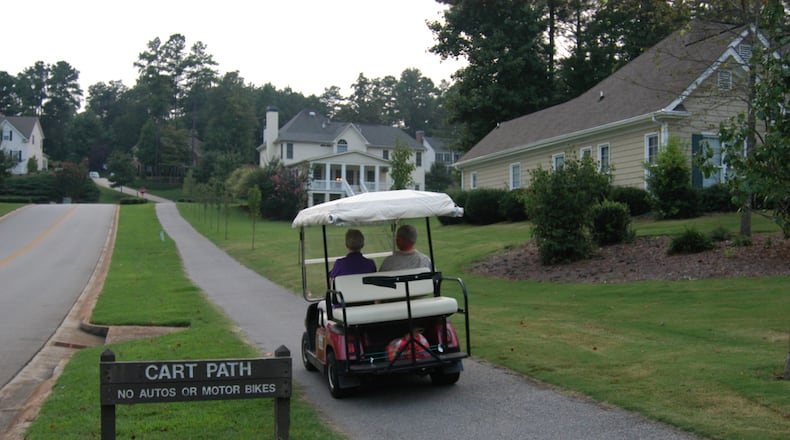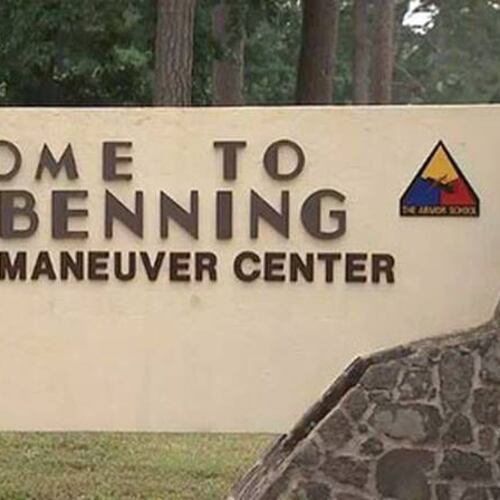Musing about Atlanta's future, Joel Cowan is motoring in an electric golf cart around Peachtree City, the suburban planned community he created 40 years ago.
He zips along the paved trail, passing Lake Peachtree and a belt of trees on his right.
At the request of The Atlanta Journal-Constitution, Cowan spent an afternoon driving around the paths of the Fayette County city to describe his vision for how the Atlanta region should grow. He borrowed Mayor Steve Brown's speedy four-seater, replete with windshield wipers and rearview mirrors.
If he had an easel and paintbrush, he wouldn't know the texture or placement of the brush strokes. But he knows how the landscape should look, and the undertone would embody hues of green.
Cowan, 65, talks a lot about open land; the buzzword is "green space." He's been espousing this concept for decades and it's apparent in Peachtree City, where flood plain has been left untouched and used as parkland. The greenscape needs to be massive and connect to other tracts of open land so people can get to it.
"The need for green space is just as important as the need for water, streets and electricity. It is a part of the quality of life we all seek," says Cowan, the first mayor of Peachtree City and one of its first residents. "It's not an option."
Leaving open land within subdivisions is in vogue with some developers, who see it as an amenity. But with the region growing so quickly, few chunks of land the size of Peachtree City's more than 15,000 acres remain.
Cowan's vision of open land and linked cart paths was the cornerstone of Peachtree City. The development, 30 miles south of downtown Atlanta, opened in 1959 and it's still considered unique. Parkland is abundant --- more than 20 percent of the development --- and open to the community through parks, two lakes and a 2,000-seat open-air amphitheater.
With 80 miles of interconnected paths for joggers, bikers and golf carts, parents can use their carts to drop off kids at school or head to the grocery store. Even the cul-de-sacs connect. Commercial development is tied to the paths and away from main roads, but there is no town center, a flaw Cowan regrets.
He's not advocating mini-Peachtree Cities around Atlanta, but some of its successes can be applied over the region. Cowan suggests that counties proclaim four growth criteria.
> Reserve 20 percent of developments for green space;
> Limit impervious surfaces (where water cannot be absorbed, such as paved parking lots) to 25 percent;
> Declare build-out targets, for example, a population cap;
> Adopt overlay planning districts on arterial roads that preserve traffic flow and prevent strip development.
"It's so simple, it's not even funny," he says. "Every day you wait, it makes it harder to get there."
Each county could determine its own percentages, Cowan suggests. "Let the counties bid for quality as opposed to who can get away with the least," he says.
By establishing the end results --- the landscape you want to see --- he believes that better development will follow. "There are economic reasons why it makes sense."
New challenges await
Gov. Roy Barnes, a longtime friend, named Cowan the first chairman of the Georgia Regional Transportation Authority, charging him with addressing the region's air quality problems.
More recently, the governor tapped Cowan to head the newly created Metropolitan North Georgia Water Planning District, a 16-county agency tackling another problem: Atlanta's declining water supply and the primary issue that could stymie the region's growth.
If building on a water source's flood plain can lead to future problems, why not leave it as open land? It adds green space and helps the environment.
As he heads by Lake Peachtree, he points to examples of preserved green space. Homes don't abut the lake, which leaves a natural buffer to help prevent erosion. Because the lots are not lakefront property, a builder would get less money for them. But the value of the development is higher because all residents have access to the waterfront.
He's a supporter of the governor's green space program, which grants money to fast-growing counties for the purchase of open land. Cowan helped define it, yet he prefers that developers start by using the flood plain as green space.
As for commercial development, Cowan favors it being accessible from side roads, not main thoroughfares. It doesn't slow traffic and it looks nicer. He pauses the cart on one of Peachtree City's covered bridges above Ga. 54, looking below at the four-lane parkway lined with trees and shopping centers set back from the road. This is the way he'd like commercial development to appear along more roads throughout the metro area.
He wants all parking in the rear of buildings. "Shouldn't be able to see hood ornaments from the road as you pass by," he says.
After the golf cart tour, Cowan hops into a car and heads north to the Clayton County Water Authority's land treatment facility southeast of Jonesboro, where more than 70 percent of the waste water is reused. He wants to show an example of how limited water resources can be utilized again.
The authority sprays treated water on about half the 4,000-acre site, which eventually filters down to a county reservoir. Just like Cowan's earlier example, some of the land doubles as public space. It's also become popular for bird-watching.
"We've got to get this concept of the value of green space," he says. "We need the open space. It's good for the soul."
WHERE WE WENT
We spent a soggy afternoon traversing some of Peachtree City's 80 miles of interconnected paths. Afterward, we headed to the Clayton County Water Authority to see its 4,000-acre water redistribution program.
About the Author
Keep Reading
The Latest
Featured


